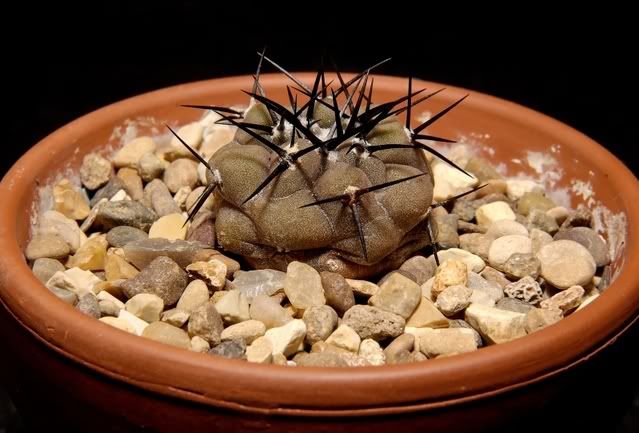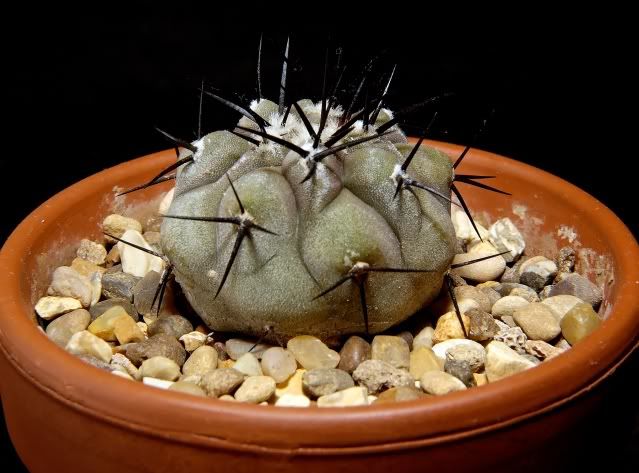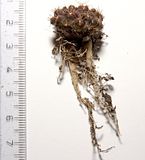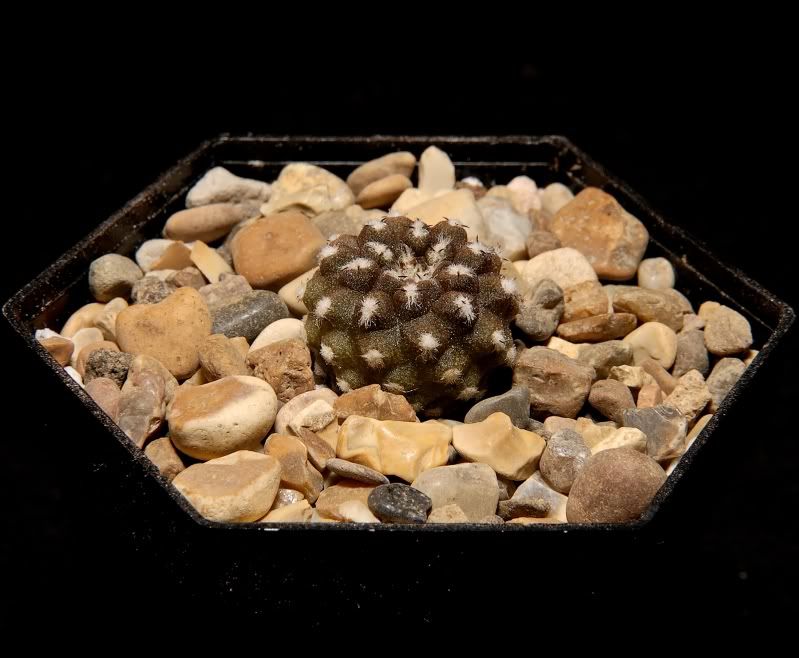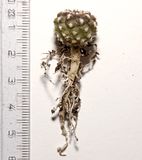My Chilean Cacti Collection 2009/2010
E. saint-pieana is among the "must have" columnar cacti.
Regrettably, seeds are hard to find and my results haven't been great.
One germinated from a Mesa packet and about 8 from who knows where else, I think the guy in Australia, of which 4 are now really strong, about an inch after one year.
A German Nursery was selling larger seedlings for about 50 Euros.
The other Eulychnias are out there.
Regrettably, seeds are hard to find and my results haven't been great.
One germinated from a Mesa packet and about 8 from who knows where else, I think the guy in Australia, of which 4 are now really strong, about an inch after one year.
A German Nursery was selling larger seedlings for about 50 Euros.
The other Eulychnias are out there.
-
Christer Johansson
- Posts: 2452
- Joined: Wed Aug 09, 2006 11:57 am
- Location: Västerås, Sweden
- Contact:
-
Christer Johansson
- Posts: 2452
- Joined: Wed Aug 09, 2006 11:57 am
- Location: Västerås, Sweden
- Contact:
The PV1922 seed at Mesa Garden was habitat collected in 2005. That's old enough for even well-stored seed to start declining. This is a plant that few people will ever set seed from in cultivation, so that restricts availability right from the start. Habitat seed is also typically more variable, often with lower overall germination and nearly always more staggered germination. The seed may also be just what was there on the day and so might not have been fully ripe.
I think also there just isn't huge demand for the genus, so not huge supply from the major growers.
I think also there just isn't huge demand for the genus, so not huge supply from the major growers.
--ian
-
Christer Johansson
- Posts: 2452
- Joined: Wed Aug 09, 2006 11:57 am
- Location: Västerås, Sweden
- Contact:
-
Spiniflores
- Posts: 72
- Joined: Mon Jul 03, 2006 9:34 pm
- Location: Chile
HelloChrister Johansson wrote:So, I've got a few E. occulta already, but none with field numberSomething to compare with later on...
Eriosyce occulta JA 81
Florencia Senoret, Juan P. Acosta (Spiniflores)
Las Breas, Taltal, 02 Antofagasta, Chile
Habitat pictures
5 cm (2") clay pot
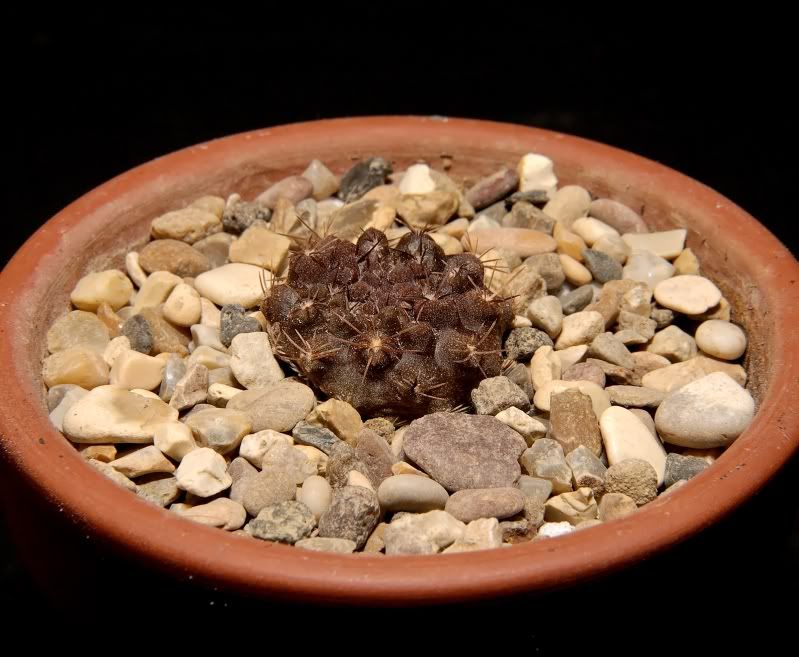
Roots
[cm/mm]
Christer, I think that you have a phenotype with softer spines but when the plants are older they look like a spineless phenotype...
JA81 is very variable, from none spines to many, long and acicular... In habitat they have a big taproot, but not too long. In cultivation, probably they do not need to store so much water as in habitat, so they do not develop just 1 main taproot and they produce many napine roots...

pictures from habitat, big difference in the same locality (and same field number)



JA81 ex-habitat

JA81 grafted on Pereskiopsis

this sp. also varies in the colour of the flower, from reddish to yellow o white cream
_________________________________________________
Cactus Chilenos en Habitat
Cactus Chilenos en Habitat
-
Spiniflores
- Posts: 72
- Joined: Mon Jul 03, 2006 9:34 pm
- Location: Chile
to the right JA50 (sowed in 2006) growing in pure granitic soil (which is very hard and the plants grow very slow -the heads remain very small, but they can develop a huge taproot)Christer Johansson wrote:Eriosyce napina ssp. tenebrica JA 50
Florencia Senoret, Juan P. Acosta (Spiniflores)
West of Domeyko, 04 Coquimbo, Chile
[Eriosyce tenebrica]
Habitat pictures
5 cm (2") plastic pot
Roots
[mm/cm]
to the left (sowed in 2009) JA50 growing in peatmoss+perlite+compost, they do not show a main taproot but they have bigger bodies.

but we must be patience because many Eriosyce (sensu Kattermann) are very similar in the first years...

PD: Chris, about your experiment with seeds of Eriosyce umadeave you MUST clean them (wash them) because the fruit is very juicy and all seeds are covered by a (brown) layer of juice which probably inhibits germination.
good luck and I hope to keep enjoying more photos of your collection.. this goes for iann too
many greetings from Chile!
Juan
_________________________________________________
Cactus Chilenos en Habitat
Cactus Chilenos en Habitat
Hi Juan!
It is always a treat to get your input on these plants. I was just on your website last week learning from it and admiring the photos you posted.
This example of the different growth due to the soil is especially fascinating:
Is that true?
It is always a treat to get your input on these plants. I was just on your website last week learning from it and admiring the photos you posted.
This example of the different growth due to the soil is especially fascinating:
In this experiment did you give these plants the same lighting? I imagine you had to water them differently because of the soil.Spiniflores wrote: to the right JA50 (sowed in 2006) growing in pure granitic soil (which is very hard and the plants grow very slow -the heads remain very small, but they can develop a huge taproot)
to the left (sowed in 2009) JA50 growing in peatmoss+perlite+compost, they do not show a main taproot but they have bigger bodies.

Is that true?
All Cacti are succulents, but not all succulents are Cacti
-
Christer Johansson
- Posts: 2452
- Joined: Wed Aug 09, 2006 11:57 am
- Location: Västerås, Sweden
- Contact:
The info about the roots is very interesting, Juan, and I made that question/theory earlier in this thread.
(Sep 22, 2009)
Very nice and educational pictures!! Thank a lot Juan!!
(Sep 22, 2009)
Now I have a good answerWhen you show your pictures of those seedling makes me think more and more about when and why they create a taproot? Real geophytes have no option, but semi-geophytes may develop it in need and/or in right conditions?
Very nice and educational pictures!! Thank a lot Juan!!
/Christer
-
Christer Johansson
- Posts: 2452
- Joined: Wed Aug 09, 2006 11:57 am
- Location: Västerås, Sweden
- Contact:
That I didn't knowSpiniflores wrote:PD: Chris, about your experiment with seeds of Eriosyce umadeave you MUST clean them (wash them) because the fruit is very juicy and all seeds are covered by a (brown) layer of juice which probably inhibits germination.
Thanks for the info!!!
-/Christer
/Christer
-
Spiniflores
- Posts: 72
- Joined: Mon Jul 03, 2006 9:34 pm
- Location: Chile
hello Christer, you are right. Some species soemtimes develop a taproot when they live in sandy soils or in flat lands (like some heinrichianas, some subgibbosas, some taltalensis...) but when they are living between rocks or in soils with more stones or in areas with more rain, they do not have just 1 taproot.Christer Johansson wrote:The info about the roots is very interesting, Juan, and I made that question/theory earlier in this thread.
(Sep 22, 2009)Now I have a good answerWhen you show your pictures of those seedling makes me think more and more about when and why they create a taproot? Real geophytes have no option, but semi-geophytes may develop it in need and/or in right conditions?
Very nice and educational pictures!! Thank a lot Juan!!
The first "Eriosyce tenebrica" was sowed only in pure granitic soils that here in Chile we call "maicillo".
But then we start to use more peatmoss and more organic matter to avoid pots so heavy. The result is a fast growing... probably because the root can grow in softer soil without too much stress.


about umadeave's seeds, I let them for 1 day in water and then its very easy to clean the surface.
I still have few seeds from habitat still with the "layer" that cover the testa... I will try to make a photo.
greetings from Chile
Juan
_________________________________________________
Cactus Chilenos en Habitat
Cactus Chilenos en Habitat
-
Christer Johansson
- Posts: 2452
- Joined: Wed Aug 09, 2006 11:57 am
- Location: Västerås, Sweden
- Contact:











